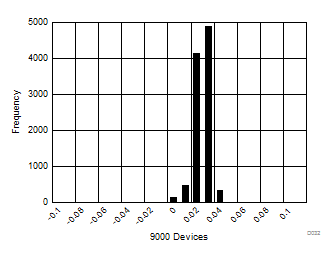-
ADS7057 14 位,2.5 MSPS,差分输入,小型低功耗 SAR ADC
- 1 特性
- 2 应用
- 3 说明
- 4 修订历史记录
- 5 Pin Configuration and Functions
- 6 Specifications
- 7 Parameter Measurement Information
- 8 Detailed Description
- 9 Application and Implementation
- 10Power Supply Recommendations
- 11Layout
- 12器件和文档支持
- 13机械、封装和可订购信息
- 重要声明
DATA SHEET
ADS7057 14 位,2.5 MSPS,差分输入,小型低功耗 SAR ADC
本资源的原文使用英文撰写。 为方便起见,TI 提供了译文;由于翻译过程中可能使用了自动化工具,TI 不保证译文的准确性。 为确认准确性,请务必访问 ti.com 参考最新的英文版本(控制文档)。
1 特性
- 2.5 MSPS 吞吐量
- 封装尺寸小:
- X2QFN-8 封装 (1.5mm × 1.5mm)
- 全差动输入范围:±AVDD
- 宽工作电压范围:
- AVDD:2.35V 至 3.6V
- DVDD:1.65V 至 3.6V(与 AVDD 无关)
- 温度范围:-40°C 至 +125°C
- 性能优异:
- 14 位 NMC DNL,±0.9-LSB INL
- 79.5dB SINAD(2kHz 时)
- 77dB SINAD(1MHz 时)
- 低功耗:
- 3.6mW(2.5 MSPS,3.3V AVDD 时)
- 160µW(100kSPS,3.3V AVDD 时)
- 82µW(100kSPS,2.5V AVDD 时)
- 集成失调电压校准
- 与 SPI 兼容的串行接口:60MHz
- 符合 JESD8-7A 标准的数字 I/O
2 应用
- 光学编码器
- 声纳接收器
- 探鱼器
- I/Q 解调器
- 光线路卡和模块
- 热成像摄像机
- 超声波流量计
- 手持无线电
3 说明
ADS7057 器件属于引脚对引脚兼容的高速低功耗、单通道逐次逼近型寄存器 (SAR) 类型的模数转换器 (ADC) 系列。该器件系列包含多个分辨率、吞吐量和模拟输入型号(有关器件列表,请参阅 表格1)。
ADS7057 是一款 14 位 2.5 MSPS SAR ADC,支持±AVDD 范围内的全差分输入,AVDD 的范围为2.35V 至 3.6V。
内部失调电压校准功能在整个 AVDD 和工作温度范围内可保持优异的失调电压规格。
该器件支持由 CS 和 SCLK 信号控制的兼容 SPI 的串行接口。输入信号通过 CS 下降沿进行采样,而 SCLK 用于转换和串行数据输出。该器件支持宽数字电源范围(1.65V 至 3.6V),可直接连接到各种主机控制器。ADS7057 的标称 DVDD 范围(1.65V 至 1.95V)符合 JESD8-7A 标准。
ADS7057 采用 8 引脚小型 X2QFN 封装,可以在广泛的工业温度范围(–40°C 至 +125°C)内正常工作。该器件体积小巧,功耗极低,非常适合需要高速高分辨率数据采集的空间受限型 电池供电 应用。
器件信息(1)
| 部件名称 | 封装 | 封装尺寸(标称值) |
|---|---|---|
| ADS7057 | X2QFN (8) | 1.50mm x 1.50mm |
- 如需了解所有可用封装,请参阅数据表末尾的可订购产品附录。
典型应用
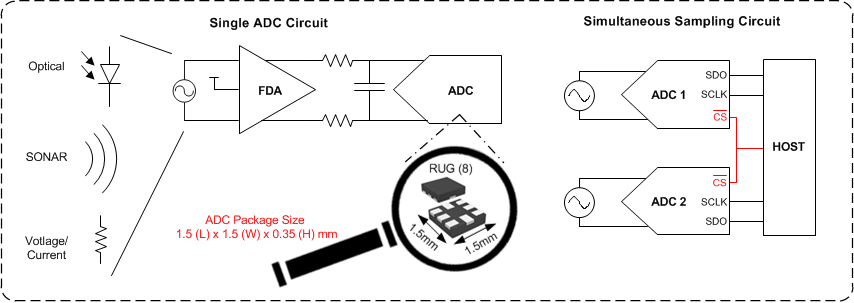
4 修订历史记录
| 日期 | 修订版本 | 说明 |
|---|---|---|
| 2017 年 12 月 | * | 初始发行版 |
5 Pin Configuration and Functions
RUG Package
8-Pin X2QFN
Top View
Pin Functions
| PIN | I/O | DESCRIPTION | |
|---|---|---|---|
| NO. | NAME | ||
| 1 | CS | Digital input | Chip-select signal, active low |
| 2 | SDO | Digital output | Serial data out |
| 3 | SCLK | Digital input | Serial clock |
| 4 | DVDD | Supply | Digital I/O supply voltage |
| 5 | GND | Supply | Ground for power supply, all analog and digital signals are referred to this pin |
| 6 | AVDD | Supply | Analog power-supply input, also provides the reference voltage to the ADC |
| 7 | AINP | Analog input | Analog signal input, positive |
| 8 | AINM | Analog input | Analog signal input, negative |
6 Specifications
6.1 Absolute Maximum Ratings(1)
| MIN | MAX | UNIT | |
|---|---|---|---|
| AVDD to GND | –0.3 | 3.9 | V |
| DVDD to GND | –0.3 | 3.9 | V |
| AINP to GND | –0.3 | AVDD + 0.3 | V |
| AINM to GND | –0.3 | AVDD + 0.3 | V |
| Input current to any pin except supply pins | –10 | 10 | mA |
| Digital input voltage to GND | –0.3 | DVDD + 0.3 | V |
| Storage temperature, Tstg | –60 | 150 | °C |
(1) Stresses beyond those listed under Absolute Maximum Ratings may cause permanent damage to the device. These are stress ratings only, which do not imply functional operation of the device at these or any other conditions beyond those indicated under Recommended Operating Conditions. Exposure to absolute-maximum-rated conditions for extended periods may affect device reliability.
6.2 ESD Ratings
| VALUE | UNIT | |||
|---|---|---|---|---|
| V(ESD) | Electrostatic discharge | Human body model (HBM), per ANSI/ESDA/JEDEC JS-001(1) | ±2000 | V |
| Charged device model (CDM), per JEDEC specification JESD22-C101(2) | ±1000 | |||
(1) JEDEC document JEP155 states that 500-V HBM allows safe manufacturing with a standard ESD control process.
(2) JEDEC document JEP157 states that 250-V CDM allows safe manufacturing with a standard ESD control process.
6.3 Recommended Operating Conditions
over operating free-air temperature range (unless otherwise noted)| MIN | NOM | MAX | UNIT | ||
|---|---|---|---|---|---|
| AVDD | Analog supply voltage range | 2.35 | 3.3 | 3.6 | V |
| DVDD | Digital supply voltage range | 1.65 | 1.8 | 3.6 | V |
| TA | Operating free-air temperature | –40 | 25 | 125 | °C |
6.4 Thermal Information
| THERMAL METRIC(1) | ADS7057 | UNIT | |
|---|---|---|---|
| RUG (X2QFN) | |||
| 8 PINS | |||
| RθJA | Junction-to-ambient thermal resistance | 177.5 | °C/W |
| RθJC(top) | Junction-to-case (top) thermal resistance | 51.5 | °C/W |
| RθJB | Junction-to-board thermal resistance | 76.7 | °C/W |
| ψJT | Junction-to-top characterization parameter | 1 | °C/W |
| ψJB | Junction-to-board characterization parameter | 76.7 | °C/W |
| RθJC(bot) | Junction-to-case (bottom) thermal resistance | N/A | °C/W |
(1) For more information about traditional and new thermal metrics, see the Semiconductor and IC Package Thermal Metrics application report.
6.5 Electrical Characteristics
at AVDD = 3.3 V, DVDD = 1.65 V to 3.6 V, fsample = 2.5 MSPS, and VCM = 1.65 V (unless otherwise noted); minimum and maximum values for TA = –40°C to +125°C; typical values at TA = 25°C| PARAMETER | TEST CONDITIONS | MIN | TYP | MAX | UNIT | |
|---|---|---|---|---|---|---|
| ANALOG INPUT | ||||||
| Full-scale input voltage span(1) | –AVDD | AVDD | V | |||
| Absolute input voltage range | AINP to GND | –0.1 | AVDD + 0.1 | V | ||
| AINM to GND | –0.1 | AVDD + 0.1 | ||||
| Common-mode voltage | (AINP + AINM) / 2 | (AVDD / 2) – 0.1 | (AVDD / 2) + 0.1 | V | ||
| CS | Sampling capacitance | 16 | pF | |||
| SYSTEM PERFORMANCE | ||||||
| Resolution | 14 | Bits | ||||
| NMC | No missing codes | 14 | Bits | |||
| INL(8) | Integral nonlinearity | –3 | ±0.9 | 3 | LSB(2) | |
| DNL | Differential nonlinearity | –0.99 | ±0.3 | 1 | LSB | |
| EO(8) | Offset error | After calibration(7) | –6 | ±1 | 6 | LSB |
| dVOS/dT | Offset error drift with temperature | 1.75 | ppm/°C | |||
| EG(8) | Gain error | –0.1 | ±0.01 | 0.1 | %FS | |
| Gain error drift with temperature | 0.5 | ppm/°C | ||||
| SAMPLING DYNAMICS | ||||||
| tCONV | Conversion time | 18 × tSCLK | ns | |||
| tACQ | Acquisition time | 95 | ns | |||
| fSAMPLE | Maximum throughput rate | 60-MHz SCLK, AVDD = 2.35 V to 3.6 V | 2.5 | MHz | ||
| Aperture delay | 3 | ns | ||||
| Aperture jitter, RMS | 12 | ps | ||||
| DYNAMIC CHARACTERISTICS | ||||||
| SNR | Signal-to-noise ratio(4) | AVDD = 3.3 V, fIN = 2 kHz | 76 | 79.6 | dB | |
| AVDD = 2.5 V, fIN = 2 kHz | 78.5 | |||||
| THD | Total harmonic distortion(4)(3) | fIN = 2 kHz | –92 | dB | ||
| fIN = 500 kHz | –90.4 | |||||
| fIN = 1000 kHz | –90.3 | |||||
| SINAD | Signal-to-noise and distortion(4) | fIN = 2 kHz | 76 | 79.3 | dB | |
| fIN = 500 kHz | 78.1 | |||||
| fIN = 1000 kHz | 77.1 | |||||
| SFDR | Spurious-free dynamic range(4) | fIN = 2 kHz | 95 | dB | ||
| fIN = 500 kHz | 93.4 | |||||
| fIN = 1000 kHz | 92.4 | |||||
| BW(fp) | Full-power bandwidth | At –3 dB | 200 | MHz | ||
| DIGITAL INPUT/OUTPUT (CMOS Logic Family) | ||||||
| VIH | High-level input voltage(5) | 0.65 DVDD | DVDD + 0.3 | V | ||
| VIL | Low-level input voltage(5) | –0.3 | 0.35 DVDD | V | ||
| VOH | High-level output voltage(5) | At Isource = 500 µA | 0.8 DVDD | DVDD | V | |
| At Isource = 2 mA | DVDD – 0.45 | DVDD | ||||
| VOL | Low-level output voltage(5) | At Isink = 500 µA | 0 | 0.2 DVDD | V | |
| At Isink = 2 mA | 0 | 0.45 | ||||
| POWER-SUPPLY REQUIREMENTS | ||||||
| AVDD | Analog supply voltage | 2.35 | 3 | 3.6 | V | |
| DVDD | Digital I/O supply voltage | 1.65 | 3 | 3.6 | V | |
| IAVDD | Analog supply current | AVDD = 3.3 V, fSAMPLE = 2.5 MSPS | 1100 | 1400 | µA | |
| AVDD = 3.3 V, fSAMPLE = 100 kSPS | 47 | 56 | ||||
| AVDD = 3.3 V, fSAMPLE = 10 kSPS | 5 | |||||
| AVDD = 2.5 V, fSAMPLE = 2.5 MSPS | 820 | |||||
| Static current with CS and SCLK high | 0.02 | |||||
| IDVDD | Digital supply current | DVDD = 1.8 V, CSDO = 20 pF, output code = 2AAAh(6) |
630 | µA | ||
| DVDD = 1.8 V, static current with CS and SCLK high | 0.01 | |||||
(1) Ideal input span; does not include gain or offset error.
(2) LSB means least significant bit.
(3) Calculated on the first nine harmonics of the input frequency.
(4) All specifications expressed in decibels (dB) refer to the full-scale input (FSR) and are tested with an input signal 0.5 dB below full-scale, unless otherwise noted.
(5) Digital voltage levels comply with the JESD8-7A standard for DVDD from 1.65 V to 1.95 V; see the Parameter Measurement Information section for details.
(6) See the Estimating Digital Power Consumption section for details.
(7) See the OFFCAL State section for details.
6.6 Timing Requirements
all specifications are at AVDD = 2.35 V to 3.6 V, DVDD = 1.65 V to 3.6 V, and CLOAD-SDO = 20 pF (unless otherwise noted); minimum and maximum values for TA = –40°C to +125°C; typical values at TA = 25°C| MIN | TYP | MAX | UNIT | ||
|---|---|---|---|---|---|
| tCLK | Time period of SCLK | 16.66 | ns | ||
| tsu_CSCK | Setup time: CS falling edge to SCLK falling edge | 7 | ns | ||
| tht_CKCS | Hold time: SCLK rising edge to CS rising edge | 8 | ns | ||
| tph_CK | SCLK high time | 0.45 | 0.55 | tSCLK | |
| tpl_CK | SCLK low time | 0.45 | 0.55 | tSCLK | |
| tph_CS | CS high time | 15 | ns | ||
6.7 Switching Characteristics
all specifications are at AVDD = 2.35 V to 3.6 V, DVDD = 1.65 V to 3.6 V, and CLOAD-SDO = 20 pF (unless otherwise noted); minimum and maximum values for TA = –40°C to +125°C; typical values at TA = 25°C| PARAMETER | TEST CONDITIONS | MIN | TYP | MAX | UNIT | |
|---|---|---|---|---|---|---|
| tCYCLE(1) | Cycle time | 400 | ns | |||
| tCONV | Conversion time | 18 × tSCLK | ns | |||
| tden_CSDO | Delay time: CS falling edge to data enable | 6.5 | ns | |||
| td_CKDO | Delay time: SCLK rising edge to (next) data valid on SDO | 10 | ns | |||
| tht_CKDO | SCLK rising edge to current data invalid | 2.5 | ns | |||
| tdz_CSDO | Delay time: CS rising edge to SDO going to tri-state | 5.5 | ns | |||
(1) tCYCLE = 1 / fSAMPLE.
 Figure 1. Serial Transfer Frame
Figure 1. Serial Transfer Frame
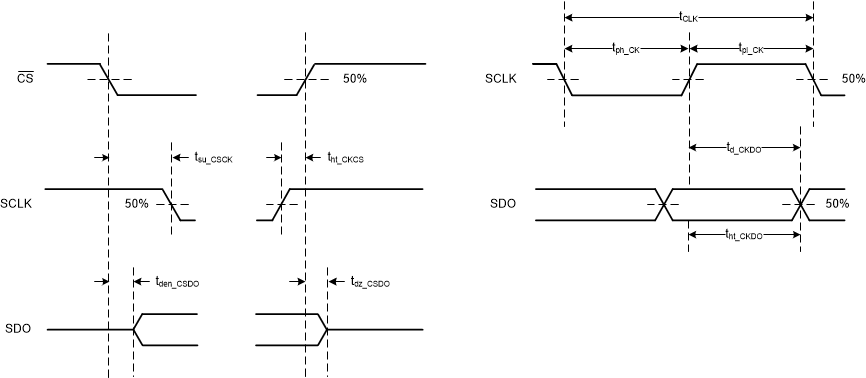 Figure 2. Timing Specifications
Figure 2. Timing Specifications
6.8 Typical Characteristics
at TA = 25°C, AVDD = 3.3 V, DVDD = 1.8 V, fIN = 2 kHz, and fsample = 2.5 MSPS (unless otherwise noted)
| SNR = 80.1 dB, THD = –96.6 dB, ENOB = 12.9 bits |
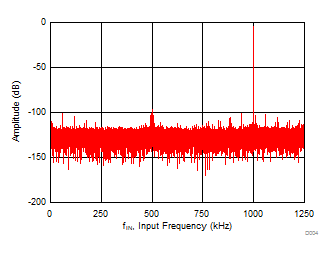
| SNR = 76.8dB, THD = –89.1 dB, fIN = 1000 kHz |
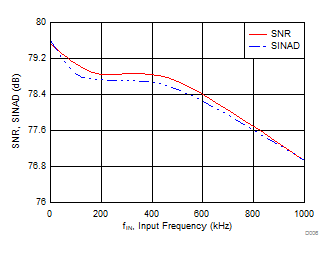
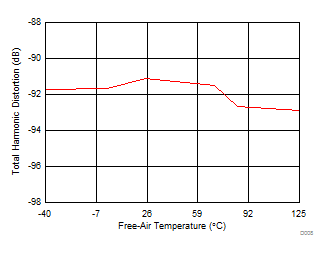
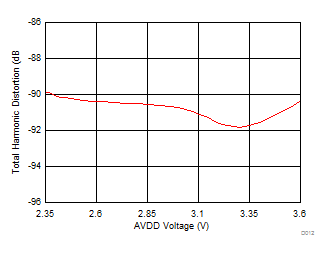

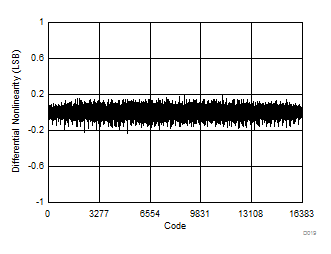

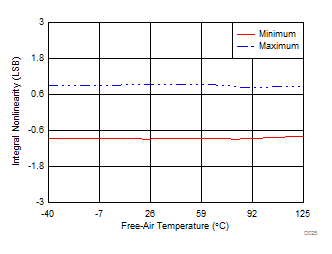
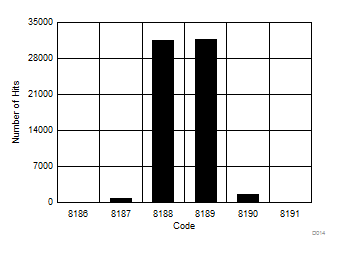
| VIN = 0 (differential) |
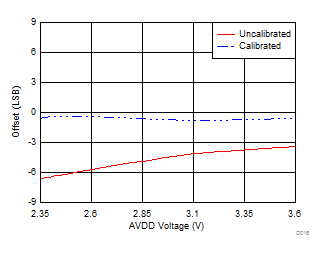
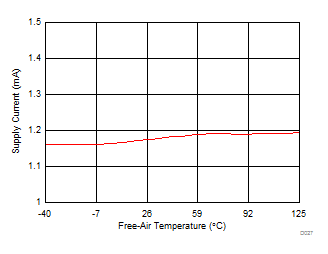


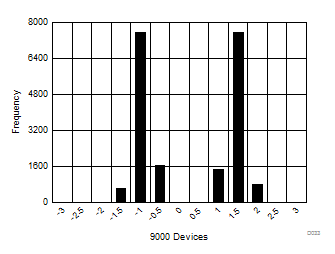
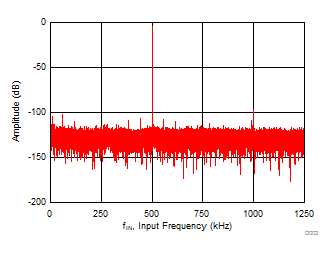
| SNR = 78.7 dB, THD = –89.1 dB, fIN = 500 kHz |
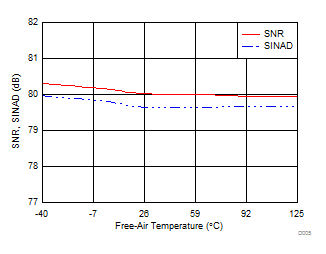
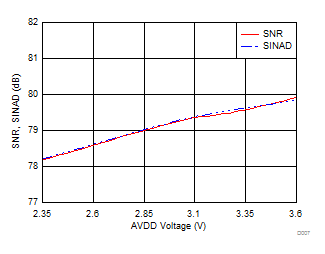
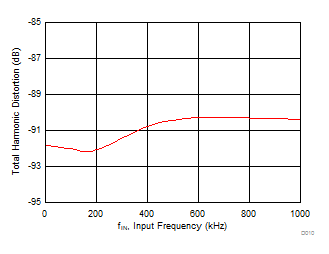

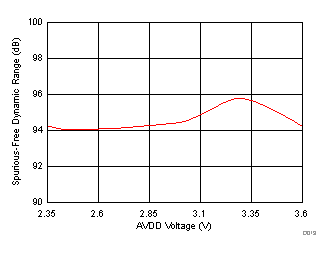
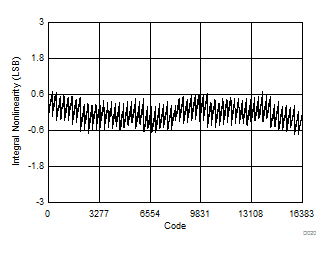
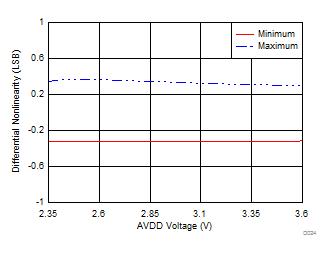
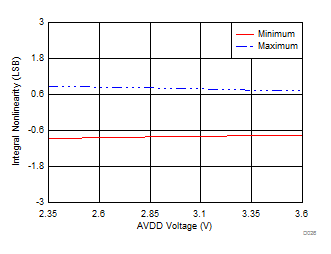
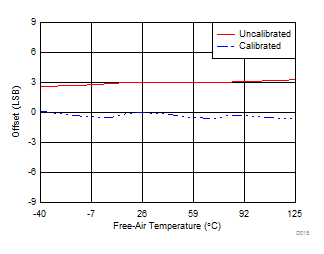
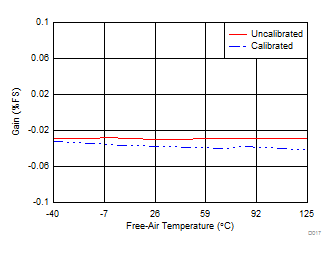
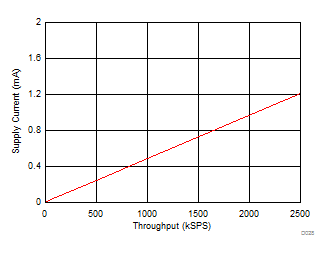

| CS = DVDD |
